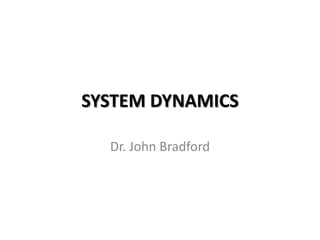
1 29-13 feedback stock-flow
- 1. SYSTEM DYNAMICS Dr. John Bradford
- 2. Feedback • Feedback Loop: occurs when changes generate effects that then influence the original causes of the change, making subsequent change either more (+) or less (-) likely. Effect Cause
- 3. Feedback Two types of Feedback: Positive Feedback 1. Positive (reinforcing, amplifying): Initial changes become amplified or magnified over time; patterns are Population Births reinforced. + + – Examples: exponential population growth; nuclear explosion; ‘rich getting richer’, etc. 2. Negative (counteracting, Negative Feedback balancing): Initial changes are counteracted or Force of balanced out, so that conditions remain Jump up Gravity relatively stable. + - – Examples: homeostasis; a thermostat; “what goes up, must come down”, etc.
- 4. Stocks and Flows Stock f lowing Stocks “Nouns” that indicate conditions or states of being at a point in time. Stocks are things that accumulate over time from flows Flows “Verbs” that represent activities or processes, which exist over time. Flows fill and drain stocks, that is, they update the magnitude of stocks.
- 5. Stock-Flow diagram of Feedback Stock-flow structure of “Positive” (Reinforcing) and “negative” (counteracting) feedback systems: Reinforcing Loop: Counteracting Loop: Exponential growth Exponential decay Populat ion Populat ion declining growing growt h decline rat e ~ rat e A feedback loop occurs whenever a change in the magnitude of a stock in turn affects a flow into or out of that same stock.
- 6. Feedback loop Dynamics When both positive and negative feedback are present in the same system, four possibilities arise: 1. exponential growth: the reinforcing loop will dominate the counteracting loop. 2. exponential decay: the counteracting loop will dominate the dominate the reinforcing loop. 3. equilibrium: they balance each other out. 4. Oscillation: it goes up, then down, up and down, … Population growing declining growth rate decline ~ rate
- 7. Dynamics of Depletion: Overshoot and Collapse The Stock-Flow Structure looks The Behavioral Dynamic looks like this: like this: Populat ion growing declining Population: 1 - 2 - 3 - 1: 1800 growt h rat e decline 3 ~ rat e Resource consuming 2 1: 900 3 2 1 1 2 3 1 3 1: 0 1 2 ~ 0.00 5.00 10.00 15.00 20.00 Page 1 Years 1:16 AM Wed, Feb 24, 2010 resources per pop Sensitiv ity Results f or Population
- 8. Dynamics of Depletion: Overshoot and Rebound If the resource is renewable, it is possible that it can rebound, but the in order for this to occur, the resources per population must go to zero before Resource does, In the context of economics, this periodic growth, collapse, and regrowth can be considered as a process of Schumpeterean “creative destruction” Population growing declining 1: Population 1: 4000 growth rate decline Resources ~ 1: 2000 consuming rate regenerating 1 1 1 1: 0 1 ~ 0.00 15.00 30.00 45.00 60.00 Page 1 Years 10:10 AM Wed, Mar 03, 2010 regeneration Population rate ~ resources per pop
- 9. Stock-flow diagram of system exhibiting overshoot behavior Po pul atio n i ni ti al 10 be in g born dyin g De ath rate D=1-R(t)/R(0) Bi rth Ra te co nsumi ng Re sou rce co nsumpti on per cap ita
- 10. Overshoot and Collapse of Population Population: 1 - 2 - 3 - 4 - 5 - 1: 1800 3 2 1: 900 3 4 2 1 5 5 4 1 2 3 1 3 1: 0 4 5 1 2 4 5 0.00 5.00 10.00 15.00 20.00 Page 1 Years 2:06 PM Tue, Mar 02, 2010 Sensitiv ity Results f or Population
Hinweis der Redaktion
- Feedback occurs when the output of a system is also an input to that same system so that a change in a condition in one part of the system creates results elsewhere in the system that in turn change the original conditions. Some examples of feedback concepts in the social sciences include vicious circles, self-fulfilling prophecies, homeostatic processes, and invisible hands (Richardson 1991). Feedback implies circular, or reciprocal causal relations, where A influences B, and B in turn influences A, and so on. Note: the term “cybernetic” refers to goal-oriented or purpose driven systems. This includes all living organisms, and many non-living systems such as thermostats and heat-seeking missiles. These systems use negative feedback in the sense that they vary their output (behavior) so that the difference between their sensory inputs (perceptions) and their goals (‘reference standards’) is minimized.
- Stockscan physical or non-physical: non-physical stocks “states of being” like anger, self-esteem, trust, etc. Importantly, non-physical stocks need not obey the Law of Conservation- they are not zero-sum. Flows are not “inputs” to stocks; they do not “influence” them, and do not “have impacts” on them. Flows can by physical or non-physical. Non-physical flows may include processes like: learning, getting angry, communicating, etc.
